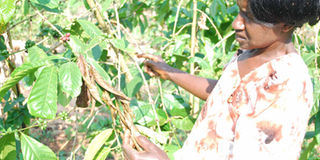The fight against coffee twig borer

A coffee farmer inspects a plant attacked by the coffee twig borer. Photo by Michael J Ssali
Robusta coffee farmers nearly all over the country are currently faced with a new pest to fight. It is the coffee twig borer (CTB) and it will substantially reduce coffee production unless a quick solution is found.
Estimates by the Uganda Coffee Development Authority (UCDA) indicate a reduction of 3.7 per cent in total national coffee export and a loss of $18m was registered in 2010/2011.
The loss is a lot bigger now since the severity of CTB infestation is higher at between five and 10 per cent nationwide.
The pest
The disease is indicated by drying twigs and branches, which means the death of coffee berries and loss of income to the farmer. In some cases, whole coffee trees are destroyed.
The CTB is a small black insect known to fly about from one plant to another like a mosquito or a fly and it has the capacity to bore a tiny hole into a twig and settle in the host twig, which finally dies. It reproduces rapidly both through sex and without sex.
A twig or branch that has been killed by the CTB normally retains the dry leaves unlike in the case of the Coffee Wilt Disease (CWD), where the leaves drop off fast.
According to UCDA, the pest was first noticed in Bundibugyo District in 1993 and it is said to have originated from India. Today, the pest exists in many other parts of the world.
Robusta coffee is only one of 225 plants that it attacks among which are tea and cocoa--all cash crops.
Physical removal
Africa, and Uganda in particular, must worry because these are the main foreign exchange earner crops.
Some people control the pest by cutting off the twigs and branches that have been destroyed by the CTB, and burning or burying them.
Since the insects settle in the host twig often they die when the twigs and branches are burnt or buried.
It must however be remembered that this method of control carries the risk of spreading an older, even more dangerous, coffee disease, CWD, because the farmer uses a sharp object to cut off the twigs and moves from one coffee tree to another and some of the trees could be carriers of the CWD even if they may not yet have shown its symptoms.
Attack other plants
A big disadvantage with this method of control is that many farmers focus their attention on cutting off infested coffee twigs and branches.
However, it is important to note that the CTB insects attack several other plant species which may be growing in the coffee garden where they remain hidden and safe, quite capable of attacking the coffee plants again.
A prudent farmer is advised to ensure that the coffee garden is cleanly weeded to rule out the possibility of the CTB settling in the weeds and acting as the bridge for cross contamination and re-infection.
It is believed that the rate of attack among well nourished coffee trees is lower, which makes regular fertiliser application advisable.
The CTB thrives better in shade grown coffee trees and the farmer, unfortunately, must reduce tree cover in the garden, which actually goes against what has always been advocated--planting trees for a better farming environment.
Using pesticides
Some farmers fight CTB by spraying the coffee trees with pesticides. But it is very important to do this with guidance from the area agriculture extension officer, who will advise what pesticides to use and how to use them so that they get to wherever the pests hide.
The fight against the CTB whether by physical means or by the use of pesticides reduces the farmer’s profits. Labour must be hired to cut off the infested twigs and the pesticides have to be bought.
Cutting off twigs and branches means loss of plant parts on which coffee cherries grow.
It is strongly recommended that the fight against the CTB is done together by all the farmers living in whole villages.
Searching for a solution
This is because if only a few farmers do so, the insects have the capacity to fly from the neglected coffee gardens to those where the infestation is rigorously fought and make new attacks.
Agricultural researchers under the National Agricultural Research Organisation are working on the problem as a priority right now and it is expected that with time, a solution will be found.




